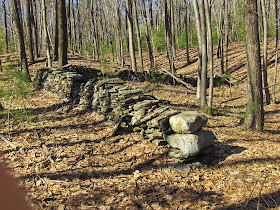Aside from the rock pile: note that the wall (back left of photo) actually continues to the right after a break.
This pattern of a wall ending and continuing in bits and pieces after the ridge dies out, was repeated in other places. Something like this:
Here it is again:
I was particularly taken with one bit of "wallism", where a couple of decrepit piles occur next to a break, and then the wall turns a corner, runs briefly down to the lower place, then stops:
Just at the left edge of the above picture, several old piles:
Let's have another look at that from near the break:
There were also some much older walls integrated in with these "fresh" ones. All worth a closer look.
Added, to clarify the wall damage at one end:








The last photo: triangular head(s?) and an undulating body portrayed by the stacking method, especially after it turns the corner, resembling scales.
ReplyDeleteWhy two heads tho?? Is there a legend/myth/story of a two headed serpent??
There is no "undulation"; it is a right angle turn at the corner.
ReplyDeleteBy "undulation" I mean the high points of the spine that show just after the "corner." As here: http://wakinguponturtleisland.blogspot.com/2015/03/serpent-stacking-undulating-body-on.html and here: http://3.bp.blogspot.com/-HIVn1MNJ1Ck/VJbLSqvad6I/AAAAAAAARMU/vu97LThsiKE/s1600/my%2Bresearch%2Bassistant.jpg
ReplyDeleteI am sorry I did not look more closely but I have a few other pictures. As far as I can tell that "undulation" is damage to the wall - where there are fallen rocks to the side of the wall. The only place the wall is of lower height is at one end, where it tapers off and is replaced by rock piles.
ReplyDeleteI'll add a photo.